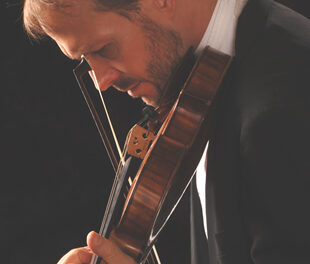“Drums and trumpets ( trombe in C Major) have been sounding in my mind for quite a while now,” wrote Robert Schumann in late September 1845, to his friend Felix Mendelssohn. Three months later he completed much of the draft of his Symphony No. 2, Op. 61 (the orchestration was finished in October 1846), which brought the Winston-Salem Symphony’s 2002-3 season to a brilliant and vigorous conclusion on May 20, in the Stevens Center. The motto theme, first heard softy played by the trumpets and horns in the slow introduction and repeated in both the second and fourth movements, helps unify the entire work, as noted by Principal Timpanist Massie Johnson, in his pre-concert “Conversation,” and in brief remarks by Music Director and Conductor Peter Perret. Johnson said that Perret used the composer’s original orchestration, which is often criticized as being too congested. Like the GSO’s retiring Stuart Malina, who shares his philosophy, Perret was largely successful in balancing the sections of the orchestra, paying close attention to ensemble and string articulation to maximize clarity. In the second movement, the first violins were nimble in executing their rapid, repeated notes; the conductor said they are called “scrub” notes because the hand-motion required is like scrubbing. The woodwinds were superb, with fine brief solos from Principal Oboe John Ellis, Principal Flute Kathryn Levy, and Principal Horn Fredrick Bergstone. The heart of the symphony, the slow movement, was ideally phrased and paced, fully bringing out its song-without-words quality. Ellis’ soulful oboe was joined by bassoonist Mark Popkin* playing a melancholy melody. Perret excelled in clearly detailing the gradual build-up of the yearning and passion, leading to what Edward Downes, writing in The New York Philharmonic Guide to the Symphony , describes as “an ecstatic climax in the woodwind(s)… against poignant trills of the violins.” The exultant conclusion, with its juxtaposition of unlike meters, fully justified timpanist Johnson’s affection for the work, which gives percussion such a prominent role.
The concert opened on a lively classical note with a beautifully balanced and rhythmically vital performance of Mozart’s Symphony No. 35, in D, K.385 (“Haffner”). Great care was paid to string articulation, and there was delicious interplay among the woodwinds and brass.
The full sweep of Romanticism was on display in the performance of Richard Strauss’ “Don Juan,” Op. 20, that followed. The opening tempos were daringly fast but the orchestra managed to stay the course. Perret secured good balances and made expressive use of subtle dynamics. The amorous interludes received their smoldering due. The five horns were perfectly matched as they “nailed” their famous theme, and the woodwinds were outstanding in the teamwork so necessary to bring this work off.
Peter Perret said that the 2003-4 season will be his 25th year as Music Director. The current season has been well chosen and executed, and I have enjoyed his use of both NCSA faculty and exciting rising young artists as soloists. It is too bad that, in the wake of the economic downturn and post-9/11 malaise, the audiences have been so small. I doubt there were fifty people in the Stevens Center balcony for the last concert. At least more were in the orchestra seating, and many carried flowers given to those who renewed subscriptions. I hope the popularity of the abridged or excerpted versions of the Classical Series Concerts on the “Saturday Nights, Live! Series” doesn’t lead to diluted or dumbed-down programming.
*Mark Anthony Popkin received a UNC (University-wide) Award for Teaching Excellence on April 9. He is a faculty member of the School of Music of the North Carolina School of the Arts.











